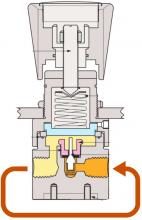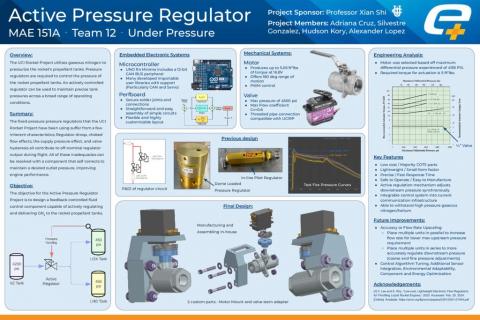UCI Rocket Project - Active Pressure Regulator
Summary
The Under Pressure Team is developing an active pressure regulator for the UCI Rocket Project. The UCI Rocket Project relies on the utilization of gaseous nitrogen to pressurize the propellant tanks of the rocket. In order to effectively manage the pressure within these tanks, pressure regulators are essential components. However, the fixed-pressure pressure regulators that have been employed by the UCI Rocket Project exhibit several inherent characteristics that hinder optimal performance. Factors such as regulator droop, choked flow effects, the influence of supply pressure, and limitations posed by orifice sizes all contribute to deviations from the desired regulator output during flight. To address these shortcomings and enhance engine performance, the integration of a component capable of self-correction to maintain a consistent outlet pressure is necessary.
Background
The UCI Rocket Project employs a dual regulator setup to manage tank pressure. It consists of Dome Loaded Pressure Regulators (DLPR) responsible for regulating most of the pressurant into the propellant tanks, and in-line spring regulators used to pilot the DLPRs. The pressures of the in-line regulators are manually adjusted prior to integration into the rocket feed system. However, during operation, this regulator setup often fails to maintain the desired pressure consistently, and instead experiences rapid pressure drops over time.
Goal and Objectives
The objective for the Active Pressure Regulator Project is to design a feedback controlled fluid component capable of actively regulating and delivering gaseous nitrogen to the UCI rocket propellant tanks.
- Produce a fluid control component capable of actively regulating and delivering N2 to the rocket propellant tanks.
- Integrate seamlessly into the rocket propellant feed system and onboard electronics.
- Easy to use and adaptable code
- Implement arming and emergency controls to prevent unintentional / unsafe operation.
Key Milestones
-
Problem Definition and Requirements (~wk4):
- Fully understand the problem and its constraints.
-
Preliminary Design Review (wk5-6):
- Present four different proposals to sponsor for the active pressure regulator.
- Decide on one design concept to pursue.
-
Proof of concept (wk9-10):
- Finalize the design that will be implemented in the spring quarter.
Key Features
- Low cost / Majority COTS parts
- Lightweight / Small form factor
- Precise / Fast Response Time
- Safe to Operate / Easy to Manufacture
- Active regulation mechanism adjusts downstream pressure synchronously
- Integrable control system into current communication infrastructure
- Able to withstand high pressure gaseous nitrogen/helium
Future Improvements
-
Accuracy or Flow Rate Upscaling
- Place multiple units in parallel to increase flow rate for lower max upstream pressure requirement
- Place multiple units in series to more accurately regulate downstream pressure (coarse and fine pressure adjustments)
- Control Algorithm Tuning, Additional Sensor Integration, Environmental Adaptability, Component and Energy Optimization
Link to documentation
- Preliminary Design Review Presentation (PreliminaryDesignReview)
Team Contacts
Adriana Cruz (acruztre@uci.edu)
Silvestre Gonzalez (silvesjg@uci.edu)
Hudson Kory (hkory@uci.edu)
Alexander Lopez (alexarl2@uci.edu)
Sponsor
Xian Shi (xianshi@uci.edu)
Advisors
David Copp (dcopp@uci.edu)
Mark Walter (m.walter@uci.edu)
Shorbagy Mohamed (mohamem2@uci.edu)


